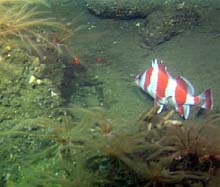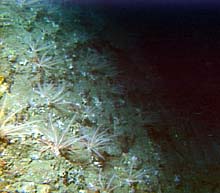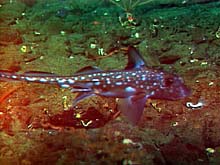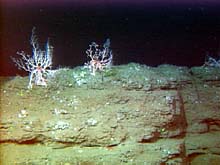
This image shows a possible flag rockfish (~30 cm) at 120 m water depth. If this is, in fact, a flag rockfish, it represents a significant range extension. Published geographic ranges for flag rockfish extend from San Francisco, CA, south to the Baja Peninsula. Click image for larger view.

On dive R617, the ROV passed over many large ridges and outcrops. This particular ridge (91 m water depth) forms a cone-shaped pinnacle that is covered with crinoids and numerous types of sponges. Click image for larger view.
A single ratfish glides over the cobble bottom at 81 mwater depth. Ratfish are related to sharks, rays, and skates, in that their skeletal structure is composed of cartilage instead of bone. Click image for larger view.
The ROPOS ROV has captured many images of basketstars engaged in a variety of behaviors. Gordon Hendler, of the Natural History Museum of Los Angeles County, CA, is particularly interested in the behavior of these echinoderms. These two basketstars (85 m water depth) have their arms spread wide open on the top of this ridge. Click image for larger view.
Rockfish Range Discovery
July 12, 2001
Susan Merle, Geological Research Assistant
Cooperative Institute for Marine Resource Studies Program, Oregon State University
Vents Program, Pacific Marine Environmental Laboratory, NOAA
and
Curt Whitmire
Cooperative Institute for Marine Resource
Studies
Oregon State University
The final dive (R617) of the remotely operated vehicle (ROV) ROPOS for the Heceta Bank cruise was conducted from 10:55 am to 11:35 pm PDT on Wednesday, July 11. ROPOS traversed across the sea floor, starting southwest of historical station 1 and heading southwest over the top of the shallow portion of the northern bank. Additional quantitative fish transects were conducted, as this was a new area for our research team. The ROV traveled over some of the most complex geologic features of the northern part of Heceta Bank, illuminating large ridges and outcrops that provided attachment substrata for diverse assemblages of invertebrates.
Some of these invertebrates included basketstars, crinoids, numerous sponges, and brittlestars. Additionally, we observed many species of fish, including greenstripe, canary, and sharpchin rockfish, as well as ratfish, a skate, and a blackeye goby. Near the end of dive R617, ROPOS had an amazing sighting of a possible flag rockfish. The sighting represents a significant range extension for this particular species of rockfish, because most publications site its known geographic range as extending from San Francisco south to Baja.
Once again, ROPOS encountered an extensive seep region. At one of these seeps, streams of bubbles were actually observed escaping from the sea floor. Water samples taken with the Niskin bottle will potentially reveal the nature of the emitted gases. As the ROV approached the area of the proposed ancient shoreline, it nimbly collected many shell samples that will be dated and may, perhaps, reveal the time period when the area was a beach. Other collections during R617 included bacterial mat from the seep region, along with one rock sample and a scallop.
Once the ROV was safely up on deck, the ship began its transit toward Newport, OR. A few hours were spent packing up all of our gear, after which most of us settled down for a long-awaited rest. We pulled up to the dock shortly before 7 am on July 12, ending a very successful summer field season.
Sign up for the Ocean Explorer E-mail Update List.































